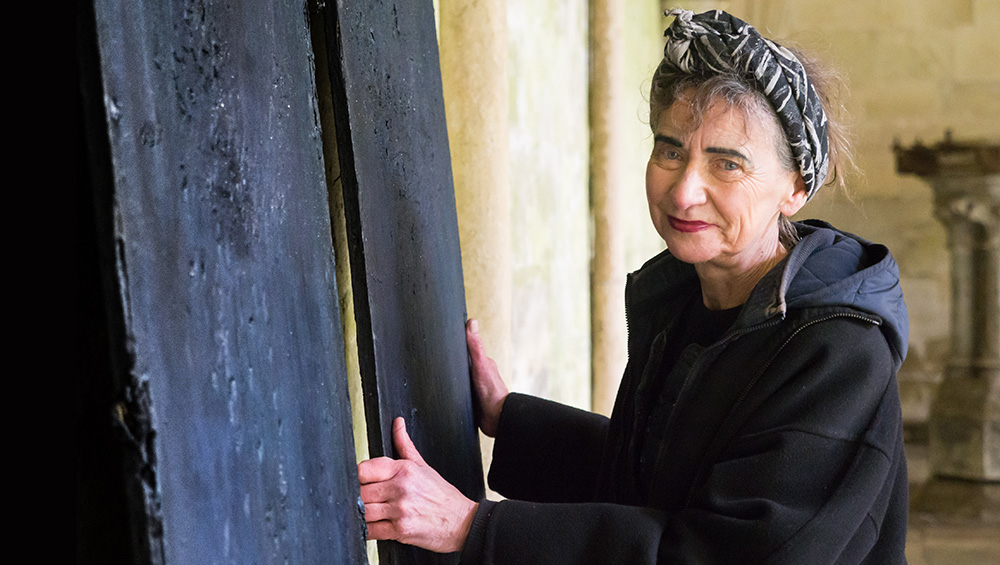
Eleanor Bartlett. Photo: Ash Mills.
by DAVID TRIGG
The pungent smell of bitumen fills the air in Eleanor Bartlett’s garden studio. Spatters of the thick, viscous substance decorate its floor, echoing the dark painted marks in the large canvases stacked against the wall. Tar is a hallmark of Bartlett’s paintings, as is wax and metal paint – materials as unorthodox as her artistic journey. Indeed, with no formal training, Bartlett (b1951) began producing art only in her late 50s, after leaving a career in physiotherapy. Since then, she has thrown herself wholeheartedly into a highly disciplined and physically demanding practice, producing a cohesive body of work that defies easy categorisation.
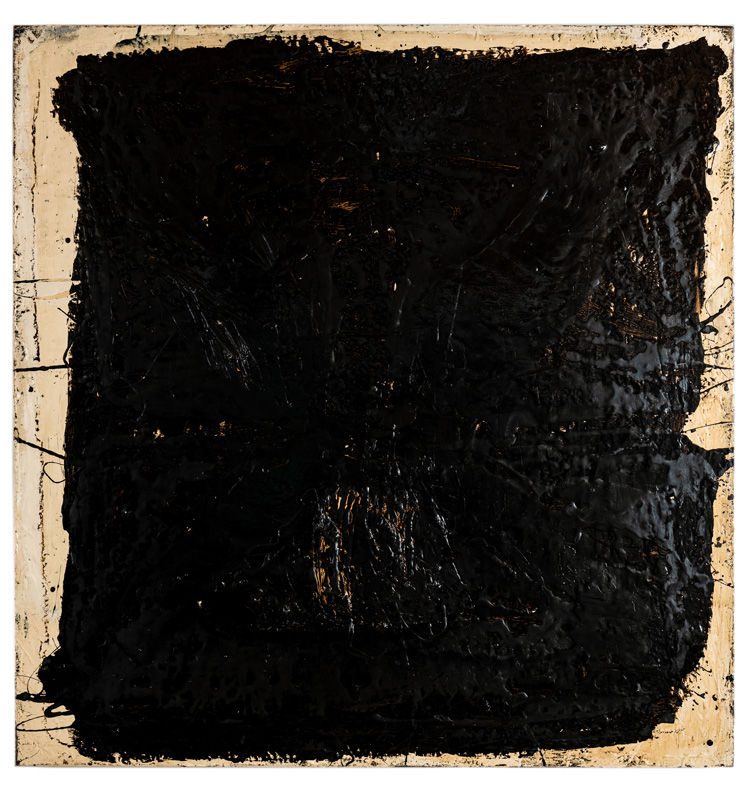
Eleanor Bartlett. Black Mass, 2019. Tar and metal paint on canvas, 110 x 112 cm. © the artist.
Some of the canvases in Bartlett’s studio are completely clotted with bitumen. Taking on a sculptural presence, their dark, geological surfaces at once evoke earthy, primordial forces and deep, cosmic reaches. In others, gestural marks and abstract motifs take precedence, and the tar is accompanied by white metal paint. Bartlett began using this industrial material to prevent the tar from rotting her canvases, although it has since become an aesthetic consideration, introducing a bold, visual contrast to the bitumen. In some works, the thick tar sits on top of the paint, in others it leaches through, or becomes visible via expressive scratched and gouged lines. In all of these works, it is the relationship between forms that underpins Bartlett’s enquiry.
Although she eschews traditional painting materials, her work reflects a deep engagement with art history. Yet her bold canvases and panels, which superficially resemble gestural abstract expressionism, possess a timeless quality that transcends 20th-century modernism. Her choice of ancient, unpretentious substances speaks to broader concerns to do with ritual, ceremony and cosmology. But these references merely orbit her practice; for her, art production is about process, about grappling with the physical properties of her materials and learning to understand them.
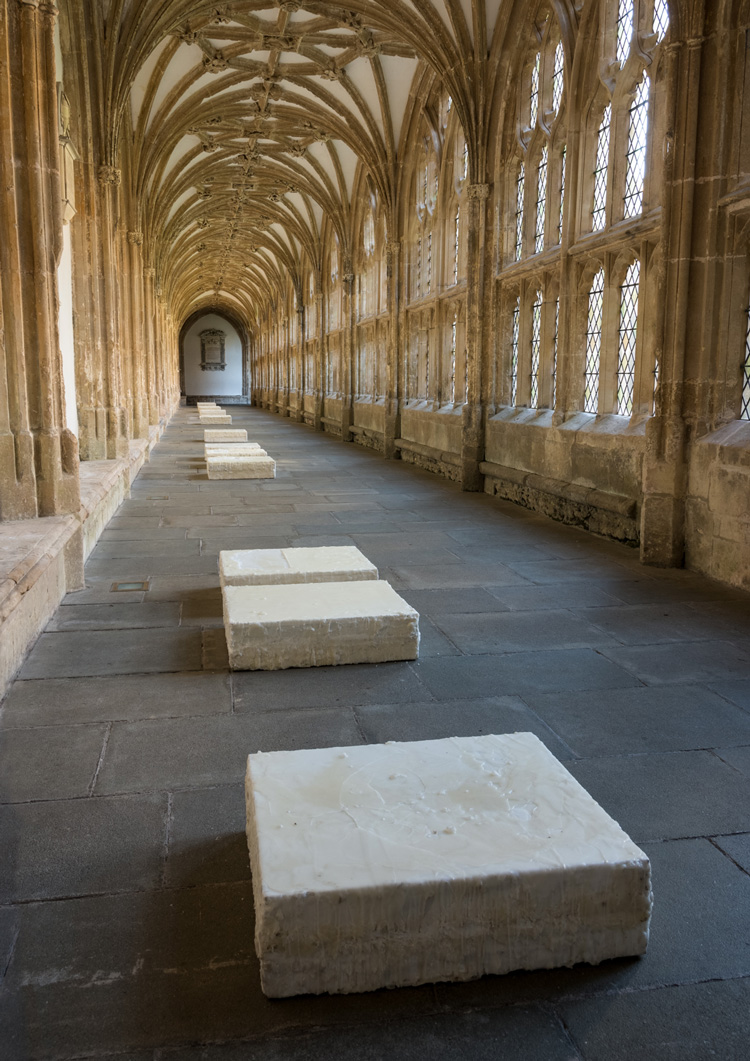
Eleanor Bartlett. Paean, installation view, Wells Cathedral, 2018. © the artist.
While wax is sometimes combined with tar in her paintings, Bartlett also uses the material to produce sculptural forms – ethereal slabs that she has previously installed in the cloisters of Salisbury and Wells cathedrals where they interrupt the space like memorial stones. As with her paintings, these sculptures are built up, layer by layer. But whereas bitumen has to be wrestled into shape, the molten wax is here allowed to take its own path. Even after it sets, she does not mark it or incise it, allowing the material to speak its own language. This emphasis on restraint and honesty to materials is central to all Bartlett’s works, which are characterised by an insistent and arresting presence.
Studio International spoke with Bartlett as she was preparing for her solo exhibition Tar and Wax: A Homage, at Three Works in Scarborough, North Yorkshire.
David Trigg: With no formal training and a very late start, your journey as an artist has been somewhat unconventional. What brought you to art-making?
Eleanor Bartlett: Drawing was my great starting point. I used to draw a lot as a child and in my teenage years; I was even poised to go to art school, but instead pursued physiotherapy. It wasn’t until my children left home and got married that I felt completely free to go ahead with making art. It was around 2010 that I started obsessively drawing natural objects – snails’ shells, leaves, flowers and other tiny things. A whole world opened up to me that was previously unknown. Some of the things you discover when you’re observing these natural forms are incredible – the Fibonacci sequence, for instance. I was thunderstruck to learn that there were repeated patterns throughout nature, in shells, waves, sound, everything. That started a whole lot of thinking and philosophising about form and matter.
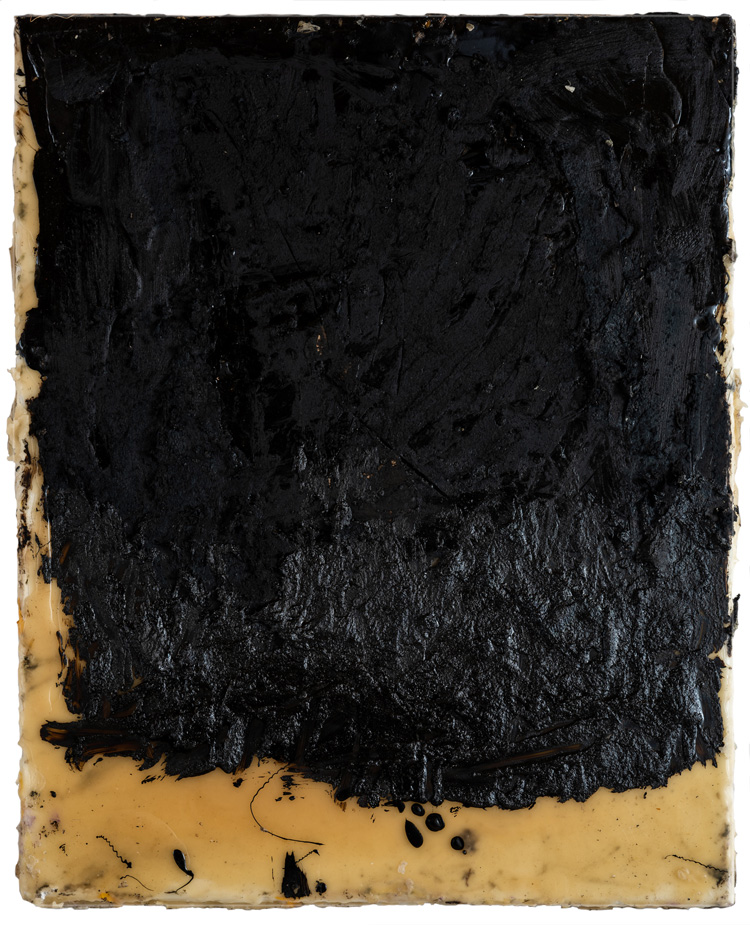
Eleanor Bartlett. Tar painting 1, 2019. Tar and wax on canvas, 60 x 50 cm. © the artist.
DT: And then you moved away from observational drawing?
EB: I had leapt into an abstract way of thinking, so it became totally irrelevant to just copy what I saw in front of me. I had to go further, dig deeper, and find out what else was going on. I remember one watershed moment in Tate Modern when I encountered an Antoni Tàpies painting for the first time. I didn’t even know who he was back then, but the painting I saw was stunning. I hadn’t realised that you could do what he was doing with painting. My world was transformed.
DT: Tar is central to your practice and while it has been used by artists including Joan Miró and Tàpies, it remains an unusual material for painting. What drew you to it?
EB: I was looking for a way of expression that involved something really gorgeous and immediate, but unpretentious. I wasn’t interested in oil paint, I wanted something that was above and beyond an ordinary experience, a substance that was creamy, chocolatey and earthy. I began looking at different products in a hardware shop and came across a tin of tar. I didn’t even know that bitumen was sold like that, but I picked it up and it was just perfect. Bitumen is such a statement of matter. When you see a great lump of tar, it’s like looking at a fundamental building block of the universe.
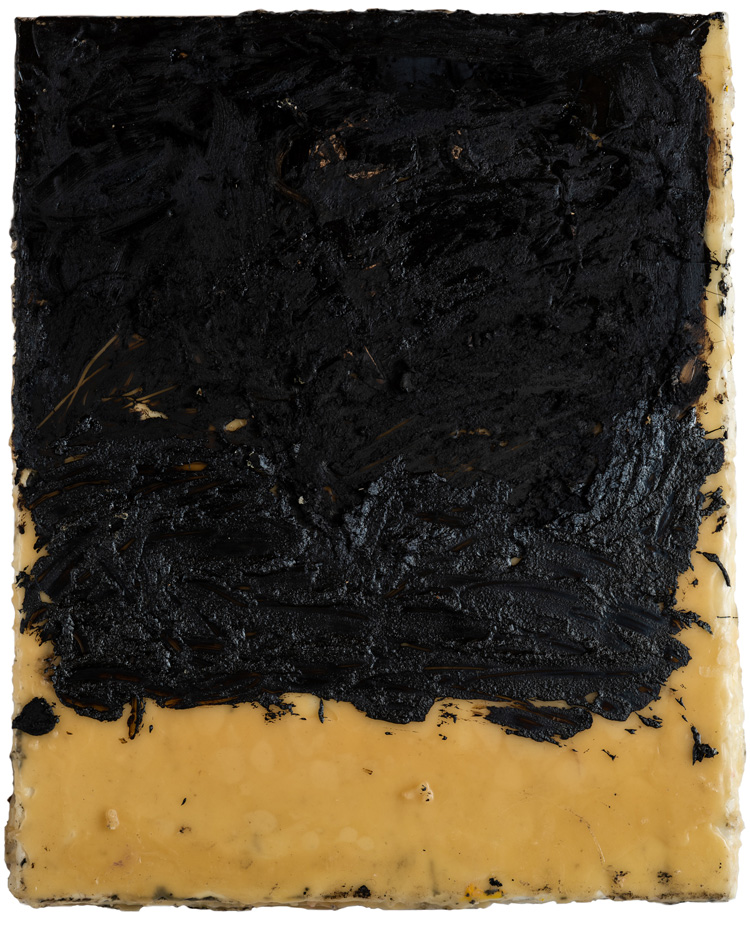
Eleanor Bartlett. Tar painting 2, 2019. Tar and wax on canvas, 60 x 50 cm. © the artist.
DT: I imagine it must be a challenging substance to work with. Do you use it neat or with thinners?
EB: It’s messy and dirty and difficult. I use it fairly neat, but it comes in different grades. You can get trowel mastic, which is hard and fudgy and quite difficult to work with, or you can get bitumen paint, which is less viscous and dries hard and shiny. It’s an incredibly hardworking and unpretentious material. Once you understand it, its personality, and you move with it, it can be beautiful and really expressive. There’s a freedom there that just doesn’t exist with oil paint.
DT: Tar is a very ancient material. It has been used for centuries for waterproofing, as an adhesive and even for embalming the dead in ancient Egypt. How conscious are you of these historical references and do they feed into the work at all?
EB: I’m very aware of these references and I feel very privileged to be using a material like this. It is wonderful to use something that belongs to the earth, as well as being a substance that people walk and drive on every day. My work doesn’t directly relate to its history, but if it can emanate some kind of information about the fundamental matter of the universe, then that is very appropriate.
DT: When you started making paintings what kind of drawings were you producing?
EB: They were becoming more about forms, just pure simple forms.
DT: So painting was a natural progression from your drawing?
EB: Yes, there was a need to go further in my exploration of form and matter. With drawing there is a limit, not a limit to how you can draw or what you can draw, but I wanted something I could get more involved with and, for me, drawing didn’t have that progressive potential. Drawing is crucial, of course, but it can be very difficult to differentiate between drawing and painting.
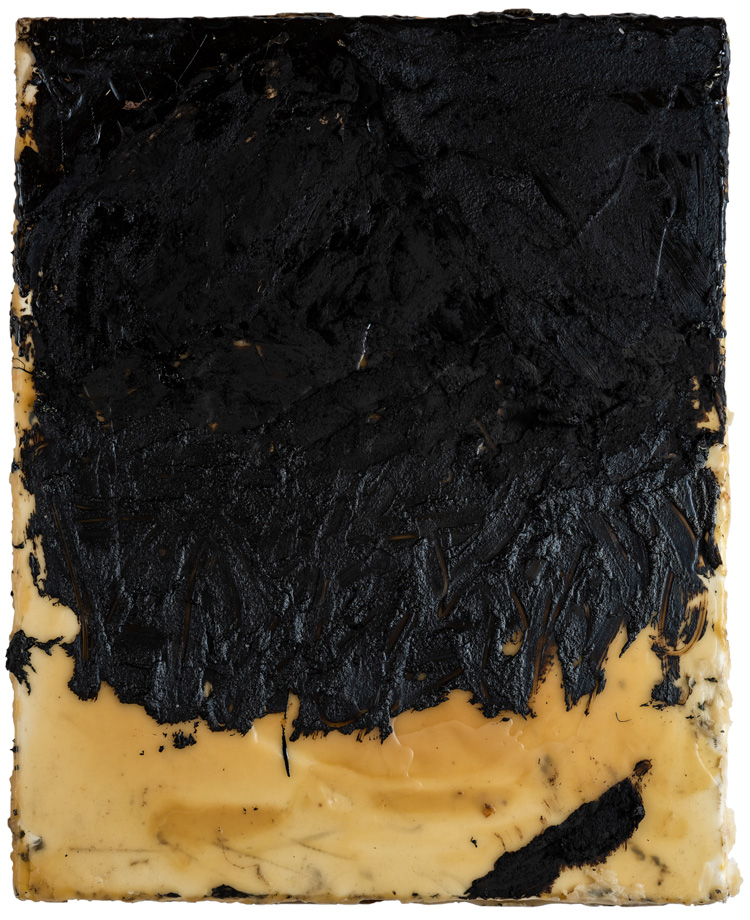
Eleanor Bartlett. Tar painting 3, 2019. Tar and wax on canvas, 60 x 50 cm. © the artist.
DT: So the line between drawing and painting is quite fluid for you?
EB: Yes. Definitions are dangerous because, for me, drawing and painting are definitely part of the same thing; you’re using the same brain, the same way of thinking, the same way of looking. I use a lot of line in my paintings, but whether that’s drawing or not who is to say? We long to define things, but perhaps it’s indefinable.
DT: In addition to tar, you also use metal paint, which plays a practical as well as an aesthetic role in your work.
EB: Yes, I started priming my canvases with metal paint to stop the bitumen from seeping through. But then I discovered its aesthetic nature, which was so perfect for the tar series. After priming, I apply a thick and lumpy layer of tar, which I then overpaint with more metal paint. Then I might mess it up a bit and off I go, making mistakes, undoing mistakes, or maybe even getting it right the first time.
DT: It sounds like a very spontaneous process.
EB: Painting is such a precarious activity. You can overthink and overdo everything. It works best for me when I am in a subconscious state of mind; that is what enables it to flow. Something happens when I’m in this particular state or zone and it becomes a process that I’m almost not a part of. It’s not rational, the subconscious takes over. But that is very rare. That’s why a good painting is also quite rare, only happening every once in a while. You have to make bad work in order to learn.
DT: Rectangles and ellipses are recurring motifs in your paintings. What is the significance of these forms?
EB: There is a huge significance to these forms. They are fundamental to the building blocks of the universe. The ellipse is the most beautiful shape and it is also a mathematical consideration. But it doesn’t have to be geometrically perfect – a puddle can still be a beautiful shape. Whatever the form is, it has a value that we either respond to or don’t, it either works or it doesn’t.
DT: Tell me about your Mater series, each painting features what appears to be a broken rectangle motif.
EB: I made a painting years ago with two forms facing each other and they suggested to me a mother and daughter, antagonising each other. But really what I was seeing was this powerful relationship between forms. Then I made a painting for a competition and I scrubbed out the “daughter” to leave just the “mother”. I called the painting Mater, meaning “mother”, but also because it is close to the word “matter”.
DT: And did you envisage it as a series?
EB: No, I was just trying to work something out. The more you work away at something, the more you find out, so it just continued.
DT: Another important material in your work is wax, which also has a very long history of use.
EB: Wax has a very different, almost ethereal quality. It has very ancient, healing properties and is associated with rituals around death and burial. That’s why I find it so interesting to marry with the earthy, downright difficult qualities of bitumen. I’m very interested in the way that wax has its own personality. It holds light in a very strange way; if you have a wax object in the gloom, it can still emanate light and it has a very suggestive, almost spiritual quality since it’s linked to rituals and religion.
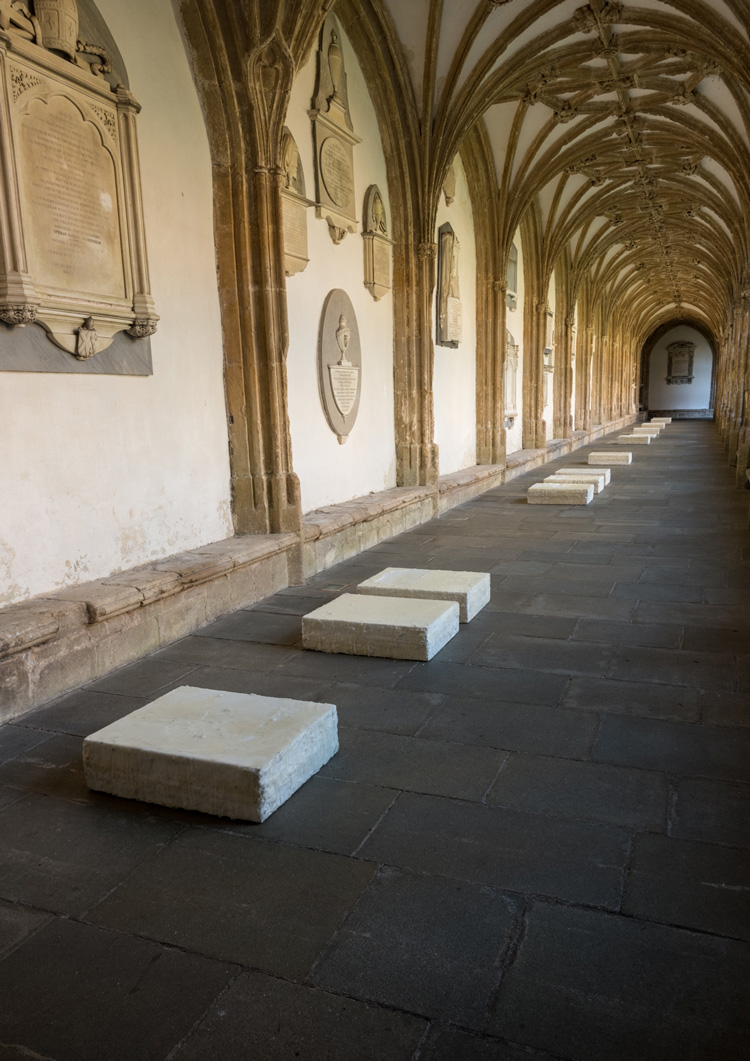
Eleanor Bartlett. Paean, installation view, Wells Cathedral, 2018. © the artist.
DT: Your installation in Wells Cathedral, Paean (2018), comprised large rectangular slabs of wax arranged along the south cloister. What inspired this work?
EB: In 2017, I made another installation with wax slabs, called Requiem, in Salisbury Cathedral, as a response to the architecture there. Wells has a completely different character; it is a most magnificent building that kind of heaves its way out of the earth and it still feels incredibly medieval. Wells has a very Carthusian aesthetic with little decoration and everything has been mathematically worked out to the last detail. Compared with Salisbury, the cloisters there are quite confined and my installation was an intuitive response to the space.
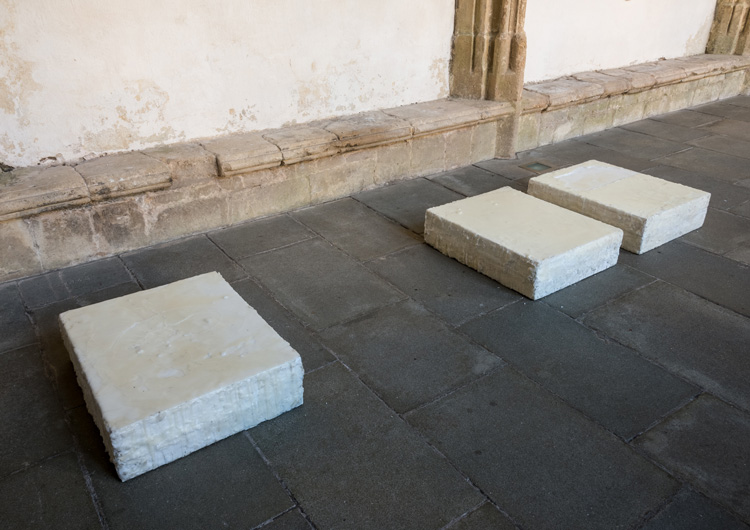
Eleanor Bartlett. Paean, installation view, Wells Cathedral, 2018. © the artist.
DT: In Salisbury you exhibited your wax slabs raised at an angle, but in Wells they were laid flat on the ground.
EB: The installation in Salisbury referenced old churchyards where the graves are all standing at angles, and also stonemason’s yards, where slabs of stone are shelved at angles. But in Wells, I didn’t feel that the south cloister would respond to them being presented at an angle, they needed to be solid and on the floor, and slightly interrupting the walkway.
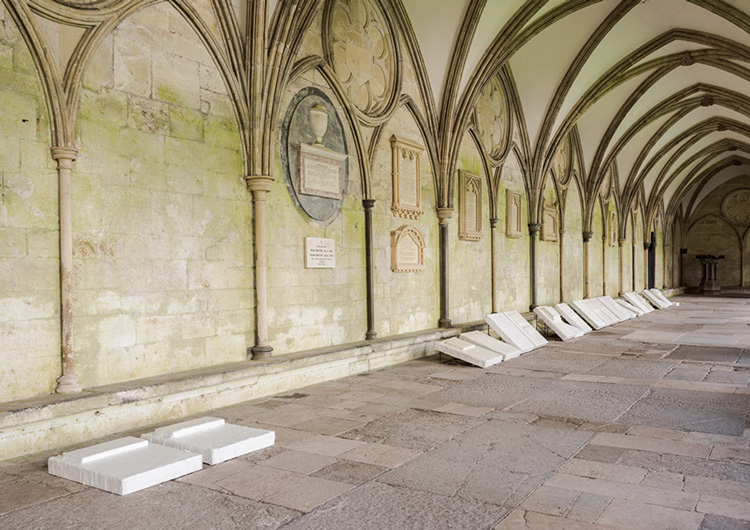
Eleanor Bartlett. Requiem, installation view, Salisbury Cathedral, 2017. © the artist.
DT: Cloisters are interesting spaces, at once inside and outside.
EB: They are waiting spaces. In 2016, I made a huge wax rectangle in Trowbridge called Waiting Room because it was made for a solicitor’s waiting room, and that is what I think cloisters are too: places of waiting. In Salisbury, I accompanied my work with Emily Dickinson’s incredible poem Because I could not stop for Death – He kindly stopped for me, which is about this endless waiting. I’m interested in the point where painting and visual arts and poetry and science all meet, where they have a similar goal that goes beyond words.
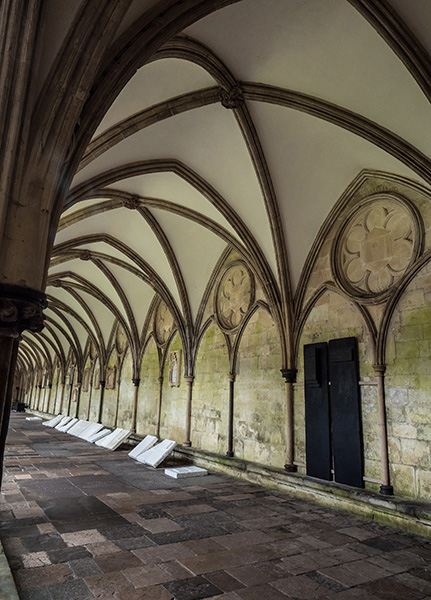
Eleanor Bartlett. Requiem, installation view, Salisbury Cathedral, 2017. © the artist.
DT: Wax is usually present in cathedrals in the form of candles, where they are used in liturgical ceremonies and celebrations. People also often light a small candle as a votive offering in an act of prayer, which additionally speaks to the notion of remembrance. Were these ideas in your thinking at all?
EB: No. Wax is very much to do with what goes on in a cathedral, but while those associations didn’t trigger my use of the material, it did make a good resonance. When I was making these blocks in Salisbury, I asked the verger if I could have some used candles and he gave me several huge sacks of them left over from the Christmas services. But as a religious thing, I want to get right out of that area and into something that predates religion.
DT: Your wax sculptures function quite differently from your tar paintings, but sometimes you do bring these very different materials together. What is the relationship between them?
EB: It’s like any relationship, you’re seeing what happens when they are together, when they are apart, what happens when they are on the same platform or not. Again it is about a response and the value of the forms.
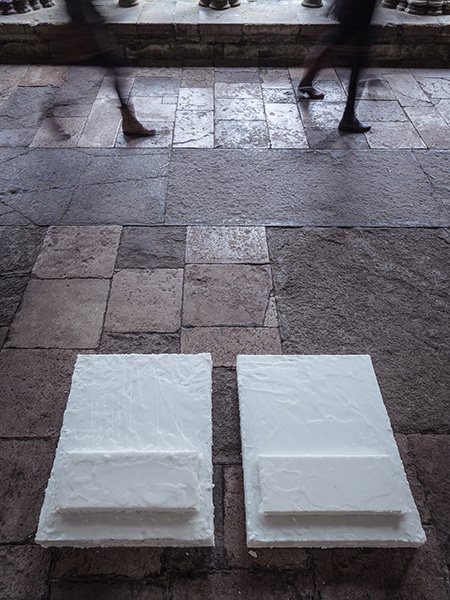
Eleanor Bartlett. Requiem, installation view, Salisbury Cathedral, 2017. © the artist.
DT: Your aesthetic is very much defined by your materials, which results in a restricted palette. Occasionally, you have used colour, such as yellow, which has appeared in a series of recent paintings.
EB: Colour is dangerous because it is so loaded with emotional inferences and you have to be careful. I like to keep a very restricted palette and, although yellow may seem miles away from that very toned-down aesthetic, to me it relates to the fact that bitumen isn’t actually black, it’s very dark brown. Yellow is in that family and can marry with the wax and tar. But you have to be careful not to over indulge it. What I’m trying to do is not about colour. As with all of my work, it is about taking it forwards, pushing the idea and making one form work in relation to another.
• Eleanor Bartlett’s solo exhibition Tar and Wax: A Homage is at Three Works, Scarborough, 11 December 2020 – 10 January 2021.